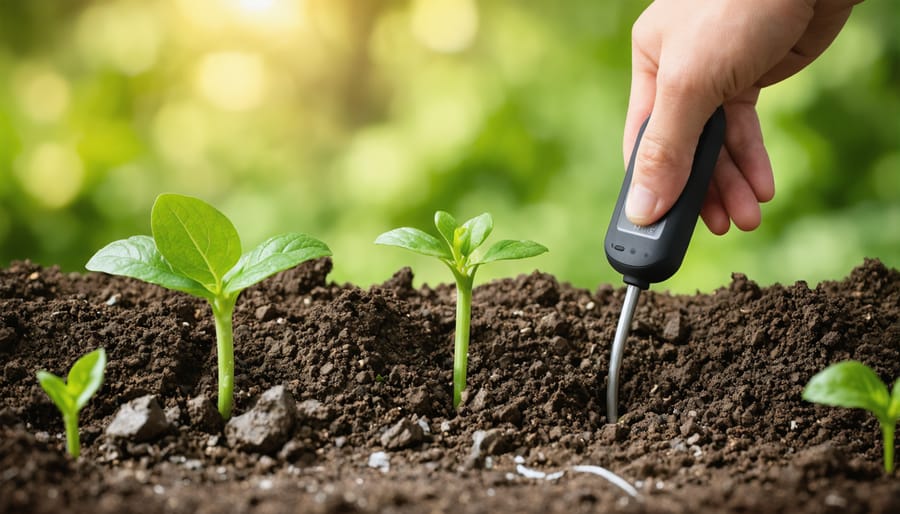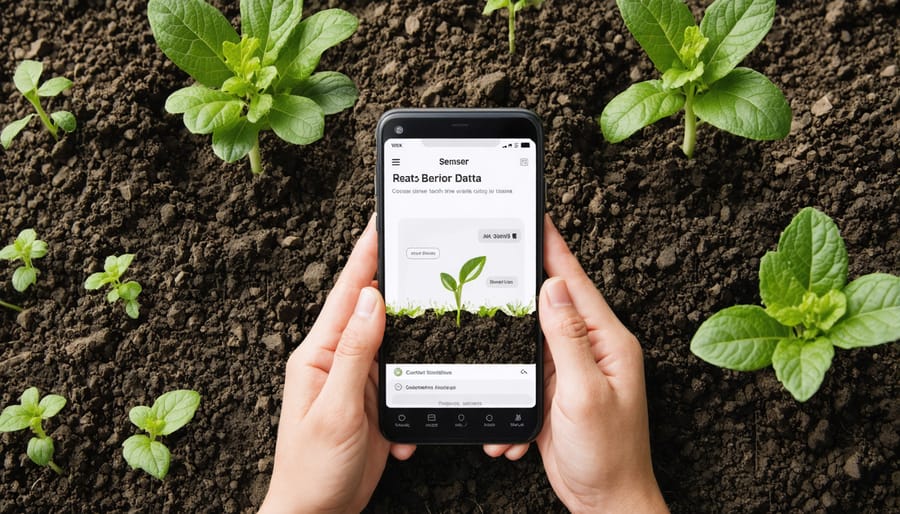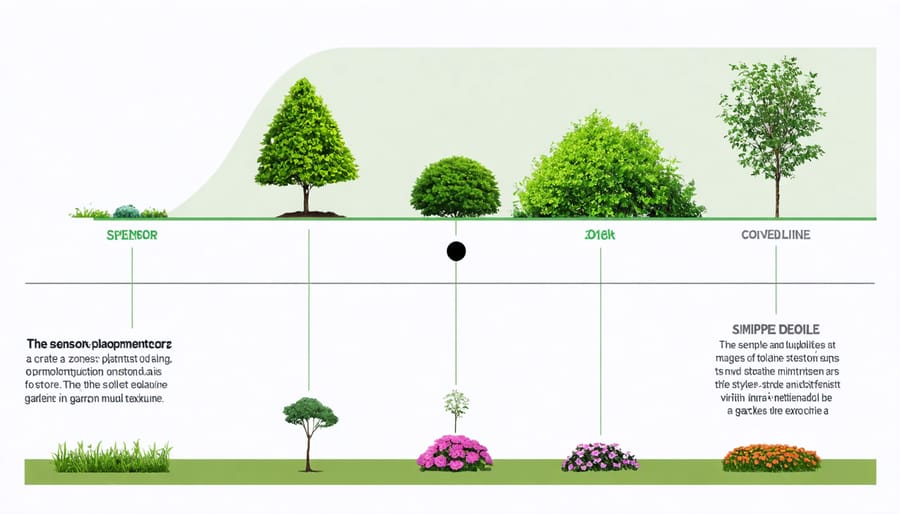Transform your garden into a data-driven oasis with smart soil sensors – tiny technological marvels that monitor moisture, nutrients, and pH levels in real-time. These wireless wizards revolutionize the way we understand and care for our plants, eliminating the guesswork that often leads to over-watering or nutrient deficiencies. By placing these compact sensors strategically throughout your garden beds, you’ll receive instant notifications on your smartphone when your plants need attention, helping you maintain optimal growing conditions while conserving water and resources.
Modern smart soil sensors do more than just measure moisture – they’re your personal garden scientists, tracking temperature, sunlight exposure, and even soil electrical conductivity to give you a complete picture of your soil’s health. Whether you’re a seasoned gardener looking to optimize your yields or a beginner wanting to keep your houseplants alive, these intelligent devices provide the precise data needed to make informed decisions about your plants’ care. With prices becoming increasingly affordable and setup as simple as pushing a stake into the ground, smart soil sensors are quickly becoming essential tools for the modern gardener.
How Smart Soil Sensors Work

Key Measurements and Data Points
Smart soil sensors are like tiny environmental detectives, continuously monitoring several crucial aspects of your soil’s health. The most basic measurement these sensors track is soil moisture, telling you exactly when your plants need water – no more guessing games! They measure moisture levels at different soil depths, giving you a complete picture of your garden’s hydration.
Temperature monitoring is another key feature, as different plants thrive in different temperature ranges. These sensors alert you when soil temperatures drift outside the optimal zone for your specific plants. For the science-minded gardener, pH measurements help you maintain the perfect acid-alkaline balance, which is crucial for nutrient absorption.
Speaking of nutrients, advanced sensors can track levels of essential elements like nitrogen, phosphorus, and potassium (NPK). They can even measure electrical conductivity, which indicates the overall nutrient concentration in your soil. Some high-end models also monitor salinity levels and organic matter content, helping you maintain ideal growing conditions.
What makes these measurements truly valuable is that they’re delivered in real-time to your smartphone, letting you make quick adjustments to keep your garden thriving.
Connectivity and Smart Home Integration
Modern smart soil sensors seamlessly connect to your home network through Wi-Fi or Bluetooth, making it easy to monitor your garden’s health right from your smartphone. Most manufacturers offer user-friendly apps that display real-time soil data and send notifications when your plants need attention. These sensors are becoming an integral part of larger garden automation systems, working alongside smart irrigation controllers and weather stations.
Popular smart home platforms like Apple HomeKit, Google Home, and Amazon Alexa often support these devices, allowing you to check soil conditions with voice commands or integrate them into your existing automation routines. For example, you can set up scenarios where your smart irrigation system responds to soil moisture readings automatically.
Many sensors also offer cloud connectivity, storing historical data that helps you track patterns and optimize your gardening practices over time. Some advanced models even connect with online plant databases to provide specialized care recommendations based on your specific plant types and local climate conditions.
Benefits for Your Home Garden
Water Conservation and Optimal Irrigation
Water conservation is a growing concern for many gardeners, and this is where soil moisture sensors truly shine. By providing real-time data about your soil’s moisture levels, these smart devices help you maintain the perfect balance between too wet and too dry. When paired with smart irrigation control systems, they can reduce water waste by up to 50% while keeping your plants healthy and thriving.
These sensors work by continuously monitoring moisture levels in your soil and sending alerts when it’s time to water. Instead of guessing or following a rigid schedule, you can water your plants exactly when they need it. This precision not only saves water but also prevents common problems like root rot from overwatering or stress from drought conditions.
For example, if you’re growing moisture-sensitive plants like tomatoes, the sensors can help maintain consistent soil moisture levels, which is crucial for preventing issues like blossom end rot. They can also detect when rain has provided sufficient moisture, automatically skipping scheduled watering cycles to prevent waste.
The best part? Most modern soil sensors can be monitored through your smartphone, making it easy to keep track of your garden’s needs even when you’re away. This means no more asking neighbors to water your plants during vacation or wondering if yesterday’s rain was enough for your garden.
Plant Health Monitoring
Smart soil sensors take the guesswork out of plant care by providing real-time insights into your garden’s health. These clever devices monitor crucial factors like moisture levels, soil nutrients, and pH balance, helping you maintain optimal growing conditions for your plants. By incorporating these sensors into your nature-friendly growing practices, you’ll be better equipped to respond to your plants’ needs before problems arise.
Most smart sensors send alerts directly to your smartphone when conditions fall outside the ideal range. For example, you’ll know immediately if your soil is too dry or if nutrient levels are depleting. This proactive approach helps prevent common issues like overwatering, nutrient deficiencies, or pH imbalances that can harm plant growth.
The data collected over time creates a valuable growing history, helping you understand seasonal patterns and optimize your gardening routine. You’ll learn which plants thrive in specific locations and how environmental changes affect your garden’s health. This knowledge is particularly useful for new gardeners who are still developing their green thumb.
By monitoring these vital signs consistently, you can make informed decisions about watering schedules, fertilization timing, and soil amendments. The result is healthier plants, better yields, and a more sustainable garden that requires less guesswork and fewer resources to maintain.

Installing Smart Soil Sensors
Optimal Placement Locations
Strategic placement of your soil sensors is key to getting accurate readings and making the most of your garden monitoring system. For vegetable gardens, place sensors in areas with different crops, as each plant type has unique moisture needs. Position them about 6 inches deep – this is where most vegetable roots actively absorb water and nutrients.
For flower beds, install sensors near both shallow-rooted annuals and deeper-rooted perennials to monitor different soil depths. If you have slopes in your garden, place sensors at both the top and bottom to track how water moves through your landscape.
For container gardens, insert sensors halfway between the center and edge of the pot, and about halfway down into the soil. In larger landscape areas, create a grid pattern with sensors every 10-15 feet to get a comprehensive picture of your soil conditions.
Pro tip: Avoid placing sensors too close to sprinkler heads or downspouts, as these areas can give misleading readings. Also, mark your sensor locations with small stakes or flags – this helps you remember their positions and prevents accidental damage during garden maintenance.

Initial Setup and Calibration
Getting your smart soil sensor up and running is easier than you might think! Start by finding the perfect spot in your garden – somewhere that represents the average soil conditions of your growing area. Avoid placing it near sprinklers or in areas with extreme conditions.
Before installation, make sure your sensor’s batteries are fresh and properly inserted. Most sensors connect to your smartphone via Bluetooth or Wi-Fi, so download the manufacturer’s recommended app and create an account. Once installed, give the sensor about 24 hours to adjust to its environment before relying on the readings.
For accurate calibration, take a manual soil reading using traditional methods (like a basic moisture meter or pH test kit) and compare it with your smart sensor’s readings. Most apps will guide you through adjusting the baseline settings to match these measurements.
Don’t forget to input details about your specific plants and soil type in the app – this helps the sensor provide more accurate recommendations. Also, remember to position the sensor at the appropriate depth, usually around root level, for the most relevant readings.
Regular recalibration every few months ensures your readings stay accurate as seasons change.
Making the Most of Your Sensor Data
Understanding Sensor Readings
Understanding your soil sensor readings doesn’t have to feel like decoding a secret message. These smart devices typically measure four key factors that can make or break your garden’s health. First up is moisture content, usually displayed as a percentage. A reading between 20-60% is ideal for most plants, with lower numbers indicating it’s time to water and higher numbers suggesting possible overwatering.
Soil pH readings typically range from 0 to 14, with 7 being neutral. Most garden plants thrive in slightly acidic soil (6.0-6.8), though some prefer more acidic or alkaline conditions. Temperature readings are straightforward – they tell you if your soil is in the sweet spot for root growth, typically between 65-75°F (18-24°C).
The nutrient readings might seem tricky at first, but they’re actually quite simple. Most sensors measure NPK levels (Nitrogen, Phosphorus, and Potassium) on a scale from 0-10 or as percentages. Low readings suggest it’s time to fertilize, while high readings mean you should hold off on adding nutrients.
Modern AI-powered garden monitoring systems can even alert you when these readings fall outside optimal ranges, taking the guesswork out of interpretation. Remember, these readings are guides – always consider your specific plants’ needs and local growing conditions when making gardening decisions.
Creating Care Routines
Creating a care routine based on your smart soil sensor’s feedback is like having a personal gardening coach. Instead of guessing when to water or fertilize, you’ll receive data-driven insights that help you develop a reliable maintenance schedule.
Start by monitoring your sensor’s readings for about two weeks to establish baseline measurements for your specific plants. Pay attention to patterns in moisture levels throughout the day and note how quickly the soil dries after watering. This information will help you determine optimal watering frequencies.
Use your sensor’s app to set up customized alerts. Most smart sensors allow you to establish threshold values for moisture, nutrients, and light levels. When readings fall outside these ranges, you’ll receive notifications prompting you to take action. This feature is particularly helpful for busy gardeners who might otherwise forget regular maintenance tasks.
Consider creating a digital care calendar that aligns with your sensor’s feedback. Include regular tasks like:
– Daily monitoring of moisture levels
– Weekly nutrient level checks
– Monthly pH testing
– Seasonal fertilizer applications
Remember to adjust your care routine based on seasonal changes and plant growth stages. During summer, you might need to water more frequently, while winter typically requires less frequent watering. Your sensor’s historical data can help you fine-tune these adjustments over time.
Pro tip: Keep a simple log of any actions you take based on sensor readings. This will help you identify patterns and optimize your care routine for better plant health.
Smart soil sensors are truly game-changing tools for any garden enthusiast. By providing real-time data about your soil’s moisture, nutrients, and pH levels, these devices take the guesswork out of gardening and help you create the perfect environment for your plants to thrive. Not only do they save you time and water, but they also help prevent common gardening mistakes like overwatering or nutrient deficiencies. Getting started with smart soil sensors is easier than you might think, and the benefits far outweigh the initial investment. Whether you’re a seasoned gardener or just starting out, implementing these sensors in your garden can lead to healthier plants, better yields, and a more sustainable approach to gardening. Take the first step toward smarter gardening today – your plants will thank you!
